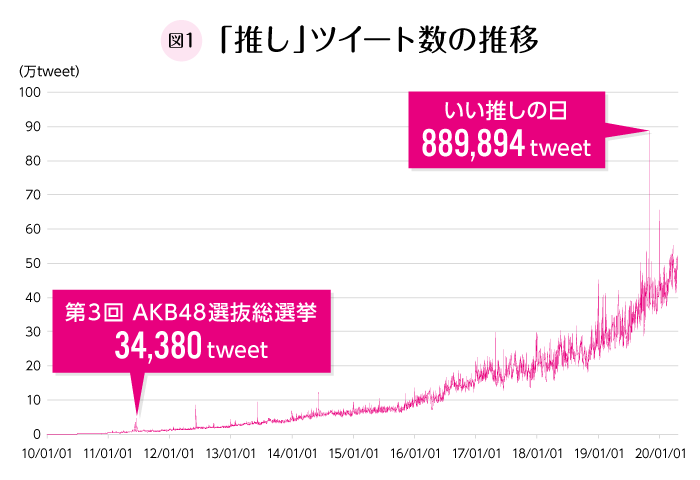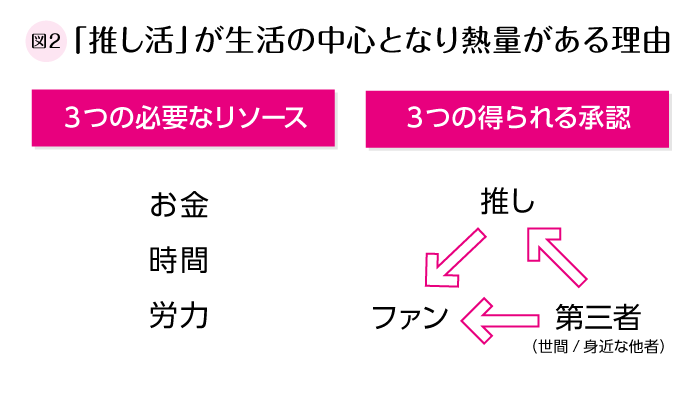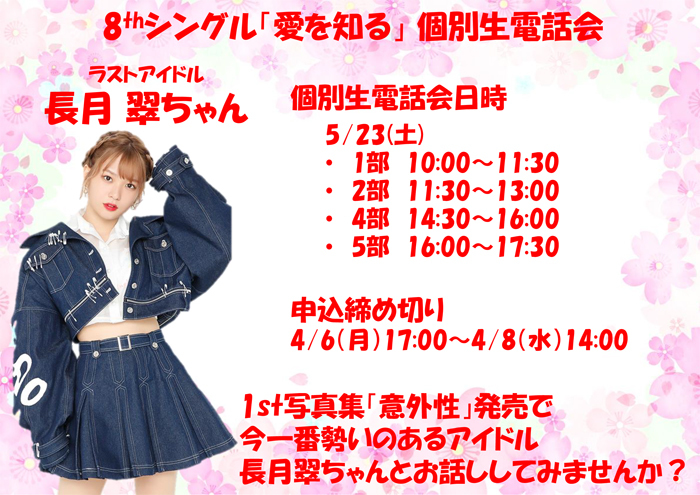Note: This website was automatically translated, so some terms or nuances may not be completely accurate.
A New Form of Idol and Fan Support: What is "Oshi-katsu," Spreading Among Young People?
This series explores idols as a theme to consider the nature of media, communication, and even entertainment. Part 2 continues from the previous installment, examining "Idols from the Perspective of Society and Consumers." Here, we unravel the current perspective of idol fans, focusing on the phenomenon of "idol fandom activities" spreading primarily among young people.
The concept of "oshi" (favorite), once a specialized term among a core group of idol fans about ten years ago, has expanded into various content areas. Today, many young people have their own "oshi" and actively engage in "oshi-katsu" (activities to support their favorite). Therefore, we will summarize the spread and reality of "oshi-katsu" and visualize the scale and intensity of each "oshi-katsu" category based on Twitter analysis.
The Emergence and Spread of "Oshi-katsu"
The concept of "oshi" within "oshi-katsu" first entered the mainstream around the time of the 2010 and 2011 "AKB Selection General Elections." This is evident from the spike in the number of tweets containing the word "oshi" on the day of the vote count for the "3rd AKB Selection General Election" in 2011.

In other words, "oshi" is a new concept of support that emerged alongside the "Selection General Election"—an event where fans actively shape an idol's future by spending money to vote for their favorite members, ranking them, and determining which members appear on CDs and music shows based on those results.
While the term "oshi" was originally a specialized term used by fans of certain female idol groups in 2011 to refer to "their favorite member within the group," its usage has now expanded beyond female idol groups to include fans of male idols, YouTubers, and athletes. It is increasingly used broadly to mean "the person/thing one likes the most within a particular category" (※1).
Furthermore, among women in their teens and twenties, its use has spread beyond entertainment to encompass beauty, fashion, and lifestyle in general. For example, it has permeated to the point where women's fashion magazine 'non-no' has featured special editions on "Oshi-katsu Girls" (Oshi-katsu: Support Activities) (※2).
Moreover, a survey found that "oshi-katsu expenses" ranked as the second most common use for New Year's money among teenage girls. This indicates that having an "oshi" is common among teenage girls, and they are so passionate that they spend their precious New Year's money to support them (※3).
Personally, I worked as a cram school tutor until last year. It left a strong impression on me how many of my junior high and high school students, regardless of gender, had diverse "favorites"—idols, bands, YouTubers, influencers, pro gamers, manga or anime characters—and devoted their precious pocket money, part-time earnings, and time to supporting them.
Next, let's examine the spread of "support activities" from a quantitative perspective. Figure 1 also suggests that "oshi-katsu" is growing more popular each year. Furthermore, November 4, 2019, was designated as "Good (11) Oshi (04) Day" – a day when Twitter users express gratitude to their "oshi" and share posts highlighting their "oshi's" merits with their followers. On this day, the number of "oshi tweets" reached a record high of 889,894 tweets.
The Reality of "Oshi-katsu"
Featured in women's fashion magazines, with teenage girls spending their New Year's money, and even a "Good Favorite Day" being established – what exactly is "favorite activity"?
While "oshi-katsu" encompasses a wide range of activities, its nature naturally varies depending on the content being supported and the individual fan. However, one common thread across all "oshi-katsu" is its intensity – sometimes becoming so central to a fan's life that it consumes them. To illustrate how "oshi-katsu" occupies the core of fans' lives with such fervor, we'll organize and introduce the three essential resources required for "oshi-katsu" and the three forms of validation gained from it (Figure 2).

Resource ①: Money
It's easy to imagine that "support activities" cost money. For idol fans, expenses like purchasing CDs bundled with event tickets (e.g., handshake events), concert tickets, and merchandise can add up significantly. In recent years, short trips to visit locations featured in anime or music videos (known as "holy site pilgrimages") have also become popular.
Resource 2: Time
"Oshi-katsu" naturally consumes time for real-world events like concerts and handshake events. But fans also spend considerable time keeping up with daily content updates—TV shows, streaming videos, member blogs, and more. However, this isn't purely negative; it also offers the positive aspect of increased interaction time and deeper engagement with their favorite idol.
Resource 3: Effort
"Oshi-katsu" isn't just about money and time; fans also invest significant effort. Fans have long existed who, to gain even a little attention from their "oshi" at events like concerts or handshake events, handcraft fans with the member's name or attend events in eccentric fashion like embroidered "special attack" outfits featuring the member's name. Furthermore, nowadays it's common for fans to comment on every SNS post or blog entry by their favorite idol. As shown in Figure 3, fans also frequently create promotional images for their favorite idol's handshake events and spread them via SNS. This kind of support, which involves not just money and time but also significant effort, is precisely what makes it rewarding and represents the true essence of "idol fandom."
Figure 3: Fan-created promotional image for Last Idol's Midori Nagatsuki's handshake event

So why do fans invest these resources into "oshi-katsu"? It's because engaging in "oshi-katsu" allows them to gain three forms of recognition.
Recognition ①: Recognition from the idol to the fan
The advent of handshake events and social media has enabled direct communication between idols and fans, giving rise to the desire for recognition: "I want my idol to acknowledge my existence." This drives fans to purchase numerous handshake tickets, repeatedly shaking hands and conversing with their idol, cherishing moments like hearing "Thank you for always coming to the handshake events."
Fans also respond to digital recognition, not just in-person. For example, some fans comment on every SNS post by their favorite idol. When they receive a "like" from their favorite idol, they take a screenshot of that moment and set it as their profile picture.
Recognition ②: Recognition for the "idol" from the wider public
Supporting their favorite idol's journey to stardom is also a crucial element of fandom activities. For instance, fans are overjoyed when their favorite idol or the group they belong to appears on TV. This includes not only music programs but even brief mentions on news shows, which can cause them to trend on Twitter.
In recent years, it's not limited to terrestrial media; their excellent performances or looks can also go viral on social media, catching the attention of many people. This phenomenon is called "〇〇-chan being discovered (by the world)." The prime example is Kanna Hashimoto, who was a local idol in Fukuoka Prefecture at the time but became a hot topic online as "too cute" after a single image went viral. She was literally "discovered by the world" due to her beauty and, thanks in part to her fans' "support activities," grew into a national actress.
Fans enjoy this process of seeing their "favorite" gain public recognition and become a star—essentially, their "favorite" being validated by society. This desire to support their growth is one of the driving forces behind "fan activities."
Recognition ③: Recognition from Close Others to Fans
Fans engaging in "oshi-katsu" do so not only for recognition from their "oshi," but also to gain recognition from those close to them. They want to be seen as "trend-savvy people who support the currently popular [oshi]" or "people with foresight who supported [oshi] long before they broke through." While in the early 2000s, many might have held negative perceptions of idol or anime fans, it's now mainstream for people to proudly list their "favorite" names in their social media profiles. This shift, alongside the widespread adoption of the term "favorite," reflects a changing societal view of otaku culture.
Precisely because we've entered an era where many people have their own "favorites," who you support has become important. People engage in "favorite-promoting activities" daily to be seen as having good taste by those around them.
As described above, the rise of social media, along with the increase in events and livestreams where fans can interact with their "oshi," has given birth to three forms of validation. Seeking this validation, fans devote significant resources to "oshi-katsu."
What is the most passionate category of "idol fandom activities"?
As explained so far, we know that "favorite activities" involve high fan enthusiasm and are closely tied to SNS. Therefore, based on SNS analysis, we will quantitatively visualize which content is supported by the most people and which content generates the highest level of enthusiasm among the various "favorite activities" that have expanded beyond idols.
Table 1 summarizes the annual number of Twitter posts, the number of users who made those posts, and the average daily number of "support" posts per fan for representative content within each "support activity" category.
For this analysis, fans are defined as users whose posts about each content were classified as expressing "positive/liking" sentiment by Dentsu Inc.'s sentiment analysis tool "mindlook". For example, someone posting "Nogizaka46's Mai Shiraishi-chan is cute," "I love Hige Dandism's song 'Pretender,'" or "Last Idol's Nanami Abe-chan's dance was great" would be defined as a fan. The daily number of posts by these fans can be said to be proportional to the passion level of fans supporting that content.

As this table shows, idol groups frequently featured in media, such as AKB48, Nogizaka46, and King & Prince, achieved high numbers in both total posts and unique posters. The manga "Demon Slayer: Kimetsu no Yaiba," which gained significant attention last year, also demonstrates high popularity.
However, looking at the number of posts per day per fan, female idol groups generally have more, indicating higher fan enthusiasm. Even female idols like Last Idol, produced by Yasushi Akimoto and born from an audition program broadcast on the TV Asahi network, which debuted in December 2017, show high fan enthusiasm with 3.58 posts per day per fan, despite not having exceptionally high post counts or poster counts. Male idol groups and YouTubers follow next in terms of high daily fan post counts. While there are exceptionally passionate cases like figure skater Yuzuru Hanyu, fan passion levels show distinct characteristics by category.
So why is the fan enthusiasm for female idol groups so exceptionally high?
One reason lies in the validation gained through the aforementioned "idol support activities." Specifically, "validation from society for one's 'favorite idol'" is frequently obtained through these activities for female idol groups.
There are three stages to an idol growing and gaining recognition from the public.
The first stage is the growth of the group your "oshi" belongs to within society. In the early stages of "oshi-katsu," both the idol you support and the idol group they belong to are often unknown. Therefore, the first step in growth is when the idol group your "oshi" belongs to is featured on music shows or variety programs.
The second stage involves the growth of your favorite idol within the group. As your favorite idol matures within the now-recognized group and becomes a standout member, they begin to receive more solo work.
The third stage is the idol's growth within the wider public eye. Supporting an idol through their "oshi-katsu" (fandom activities) means cheering them on until they graduate from the idol group or become an idol who can compete under their own name, rather than the group name.
For example, former AKB48/HKT48 member Rino Sashihara started dancing on the very edge of the stage during AKB48's music show performances. She leveraged her unique character and talk skills to become prominent within the AKB48 group. After graduating, she now actively works as a talent under her own name. This illustrates how female idol groups provide content that allows for sustained, medium-to-long-term "idol support" activities, not just a brief moment of fame.
Another reason lies in the communication skills idols use to draw fan reactions on social media. Typically, celebrities' social media posts mainly announce events or media appearances, with a few glimpses into their private lives, but posts aimed at two-way communication with fans are rare.
However, female idols frequently post lighthearted content like "Good morning!" or "Good night (*_ _)zzZ" or "○○ was delicious," encouraging casual fan comments, or directly ask fans for opinions, such as "Which outfit should I wear to tomorrow's event?" This actively fosters two-way communication. Furthermore, while they can't reply to every single fan comment, they post messages like "Thank you for all the replies ✨ I'll be performing in the red outfit at tomorrow's event (o^-^o)" that convey they've read each comment, deepening their relationship with fans. By constantly engaging in this two-way communication with fans, they keep fan enthusiasm consistently high.
Connecting "Oshi-katsu" to Problem-Solving Solutions
As discussed, the concept of "oshi"—once specialized jargon among core idol fans—has expanded across diverse content. We now live in an era where many young people have their own "oshi" and engage in "oshi-katsu." Furthermore, "oshi-katsu" occupies a central place in consumers' lives, and the high level of passion held for one's "oshi" is clear.
Furthermore, efforts are already underway to leverage this high level of enthusiasm from "idol fandom activities" to solve challenges for brands and media. While details will be covered next time, utilizing idols in brand communications creates a virtuous cycle where brands, consumers, and idols each benefit. By featuring idols supported by consumers, brands are accepted within the context of supporting those idols. This transcends mere tie-ups, providing access to fan communities and becoming a solution for brands.
It's also clear that SNS is where the energy of this "idol fandom activity" converges. This is precisely why brands need to analyze SNS to understand the fans of the idols or content they wish to feature in their communications. We will undoubtedly see more cases where brands, idols, and fans connect on SNS through the energy of "idol fandom activity."
Source/Reference
(※1) "Practical Japanese Expression Dictionary"
http://www.practical-japanese.com/
(※2) "What Are 'Oshikatsu Girls'? Non-no Explores the Reality of Its Reader Base" SHUEISHA ADNAVI
https://adnavi.shueisha.co.jp/news/7591/
(※3) "Teen Girls Want to Spend Their 'Oshikatsu' Money!? Simeji Ranking: Teen Girls' Top 10 Ways to Spend Their New Year's Money"
https://prtimes.jp/main/html/rd/p/000000375.000006410.html
Was this article helpful?
Newsletter registration is here
We select and publish important news every day
For inquiries about this article
Author

Teruya Saruwatari
Dentsu Inc.
Solution Creation Center
Solution Planner
Master of Science in Engineering (Industrial Engineering and Marketing). Since joining the company, has worked in the Solutions Division, primarily engaged in social media analysis and strategy development for the entertainment sector, including idols, movies, and sports. Also handles PR initiatives utilizing social media and live streaming platforms.


